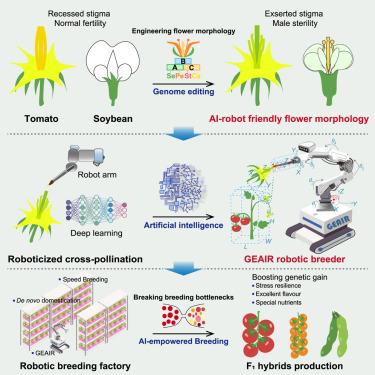Engineering crop flower morphology facilitates robotization of cross-pollination and speed breeding
IF 42.5
1区 生物学
Q1 BIOCHEMISTRY & MOLECULAR BIOLOGY
引用次数: 0
Abstract
Artificial intelligence (AI) and robots offer vast opportunities in shifting toward precision agriculture to enhance crop yields, reduce costs, and promote sustainable practices. However, many crop traits obstruct the application of AI-based robots. One bottleneck is flower morphology with recessed stigmas, which hinders emasculation and pollination during hybrid breeding. We developed a crop-robot co-design strategy in tomatoes by combining genome editing with artificial-intelligence-based robots (GEAIR). We generated male-sterile lines bearing flowers with exserted stigmas, and then trained a mobile robot to automatically recognize and cross-pollinate those stigmas. GEAIR enables automated F1 hybrid breeding with efficiency comparable to manual pollination and facilitates the rapid breeding of stress-resilient and flavorful tomatoes when combined with de novo domestication under speed-breeding conditions. Multiplex gene editing in soybean recapitulated the male-sterile, exserted-stigma phenotype, potentially unlocking robotized hybrid breeding. We demonstrate the potential of GEAIR in boosting efficiency and lowering costs through automated, faster breeding of climate-resilient crops.

工程作物花形态有利于异花授粉和快速育种的自动化
人工智能(AI)和机器人为转向精准农业提供了巨大的机会,可以提高作物产量、降低成本并促进可持续发展。然而,许多作物性状阻碍了人工智能机器人的应用。一个瓶颈是花的形态与凹柱头,这阻碍了去雄和授粉在杂交育种。我们通过将基因组编辑与基于人工智能的机器人(GEAIR)相结合,开发了一种番茄作物-机器人协同设计策略。我们培育出雄性不育系,花上有外露的柱头,然后训练一个移动机器人自动识别这些柱头并进行异花授粉。GEAIR能够实现自动化F1杂交育种,其效率与人工授粉相当,并在快速育种条件下与重新驯化相结合,促进了抗压力和美味西红柿的快速育种。大豆的多重基因编辑重现了雄性不育、外露柱头表型,有可能开启机器化杂交育种。我们展示了GEAIR在提高效率和降低成本方面的潜力,通过自动化,更快地培育适应气候变化的作物。
本文章由计算机程序翻译,如有差异,请以英文原文为准。
求助全文
约1分钟内获得全文
求助全文
来源期刊

Cell
生物-生化与分子生物学
CiteScore
110.00
自引率
0.80%
发文量
396
审稿时长
2 months
期刊介绍:
Cells is an international, peer-reviewed, open access journal that focuses on cell biology, molecular biology, and biophysics. It is affiliated with several societies, including the Spanish Society for Biochemistry and Molecular Biology (SEBBM), Nordic Autophagy Society (NAS), Spanish Society of Hematology and Hemotherapy (SEHH), and Society for Regenerative Medicine (Russian Federation) (RPO).
The journal publishes research findings of significant importance in various areas of experimental biology, such as cell biology, molecular biology, neuroscience, immunology, virology, microbiology, cancer, human genetics, systems biology, signaling, and disease mechanisms and therapeutics. The primary criterion for considering papers is whether the results contribute to significant conceptual advances or raise thought-provoking questions and hypotheses related to interesting and important biological inquiries.
In addition to primary research articles presented in four formats, Cells also features review and opinion articles in its "leading edge" section, discussing recent research advancements and topics of interest to its wide readership.
 求助内容:
求助内容: 应助结果提醒方式:
应助结果提醒方式:


